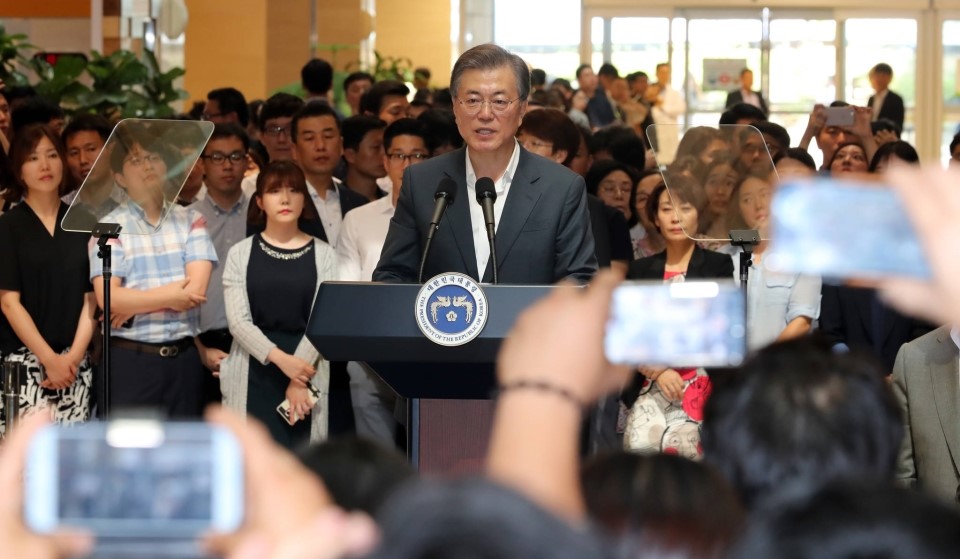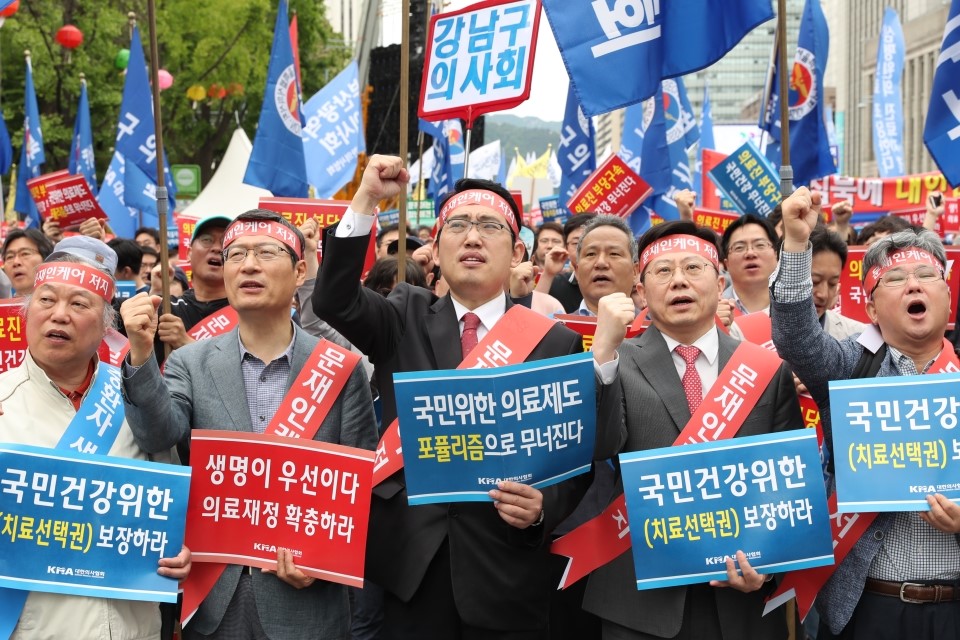President Moon Jae-in announced a new healthcare policy on August 9, 2017 that would drastically expand the coverage of health insurance, providing new and enhanced benefits that reduce financial burden on the public and improving the life quality of patients’ families. However, they left out the details of how to accomplish these objectives and plans to further debates, making it necessary for the medical community and the government to negotiate a way forward.
‘MoonCare’ aims to increase the national insurance coverage rate from 63.7 percent to 70 percent. The overall tendency of the new plan is to relocate 3800 currently non-covered medical services, such as MRI screenings, examinations for the influenza virus, CT scans in the chest area and so forth, under the coverage of public insurance. Each service will be reassigned into either the regular 70 percent coverage items or the reserve coverage items. Reserve coverage is seen as the bridge between state-covered and non-covered services, where graded benefits are assigned to the treatment’s safety, effectiveness, and necessity. The coverage may vary from 10 percent to 50 percent.
 |
| ▲ President Moon Jae-in briefing MoonCare at Seould St. Mary's Hospital (Picture presented by Cheong Wa Dae stationed press corp) |
Further major benefits that MoonCare would bring are for appointed meetings with the doctor, charges for hiring care workers, and the accessibility of premium hospital rooms. For example, those patients with needs that are deemed medically necessary can be assigned a single ward with the assistance of the state. Insurance for care worker fees are also expected to guarantee family members of patients can carry on with their work and lives. In addition, MoonCare reinforces aid for children, elders, and patients in low-income brackets. Setting a limit to an individual’s annual medical expenditures where the lowest 30 percent stratum only have to pay 1 million KRW at most, with the rest of their fees covered by the state. If government calculations are correct, the new policy will decrease on average, individual medical expenditures nationwide by 18 percent and 46 percent for those in low-income brackets.
To proceed with the proposed changes, government has plans to investing a total of 30.6 trillion KRW from 2017 to 2022. About half of the National Health Insurance Service’s (NHIS) 21 trillion KRW in savings will be used. The rest of the budget will be raised from government funds and profit from a planned insurance premium hike.
In spite of the expectations that President Moon’s health insurance policy will reduce the burdensome healthcare costs on the public at large, the medical community is not that optimistic. This policy has been met with criticism from opposition parties too, that say the planned financing is insufficient and the income of doctors will be threatened. “If the MoonCare plan is enforced, there will be a lot of small hospitals and community hospitals that will feel the burden of the crises or even worst, go bankrupt,” said one of anonymous opponents. The Korean Medical Association’s (KMA) new leader Choi Dae-jip announced a war against the planned policy changes upon his election and has been calling on doctors to take action, to stop the execution of MoonCare.
 |
| ▲ President and members of KMA protesting against MoonCare. |
The argument of the KMA is that the plan excludes the expertise of the medical community and is merely focused to populism. According to the KMA, the government cannot afford 30.6 trillion won. Right not, NHIS has 20 trillion in savings, but with the enforcement of MoonCare, the KMA predicts that, savings will be drained. This will lead to a need to drastically raise insurance premiums in the near future, placing the burden to working people.
Switching non-covered services to state-covered or reserved-covered categories also brought strong opposition from the medical community. Non-covered services are beyond the reach of the NHIS’s evaluation. Unlike state-covered services, each hospitals determines the price of the treatment and NHIS has no authority to assess whether or not the treatment is necessary or appropriately valued. With state-covered services, the cost of a treatment is the same regardless the hospital. If the NHIS determines that treatment is unnecessary, it can refuse to pay for the reported treatment. Moreover, hospitals state that for years, they have been living off the revenues generated by non-covered services. They predict massive loss from the transition. The KMA insist that current medical charges are severely underrated and a review of the fees of current state-covered services has to be guaranteed prior to the enforcement of MoonCare.
The KMA also criticizes the policy because it oppresses the freedom of practice of doctros’ and the patient’s freedom of choice. For example, the government announcing coverage of up to 3 epigastric ultrasounds annually, while doctors are concerned about the possibility of further examinations being required. Furthermore, the government stipulated that it will only pay for magnetic resonance imaging (MRI) performed by licensed doctor. The KMA and radiology technologists jointly denounced the decision as it undermines the doctor’s freedom in medical practices. The conflict between the doctors and the government has been on-going since the summer of 2017 and it seems clear they are unable to resolve the matter.
To learn more about possible solutions to conflict the Dankook Herald (DKH) interviewed Kim Jong Myoung from the Citizens’ Solidarity for Welfare State (CSWS). Kim sees the new policy as the government’s determination to administrate current non-covered medical services. Since everything about non-covered services is in the hands of hospitals, the government finds it necessary to stabilize the costs and filter out excessive treatment practices.
However, offering non-covered medical services should not be viewed as the immorality of the medical community. Kim agrees that the medical charges for state-covered services are undervalued. They may differ by publishing institute, but generally, the medical charge is about 90 percent of the actual operation costs. (The KMA claims it is closer to 70 percent, according to 2006 NHIS data.) Undervaluing charges definitely forces hospitals to rely on profit from non-covered services, forcing them to overcharge for these types of services.
The conflict between the government and the doctors is a matter of trust. In the past, the government often failed to meet its obligations to subsidize the insurance premium fund. Regulations state that the government should subsidize 14 percent of the expected insurance premium collection, however in reality; they have only been paying about 11 percent of the promised aid. As a result, it is natural for doctors to feel skeptical about the announced plans to expand the benefit.
In addition, the long history of undervalued medical insurance fees affects the level of trust between doctors and the government. Although MoonCare includes a raise in insurance premiums, an adjustment to medical cost to make up for the losses, and measures for hospitals to dispute financial conflicts, the doctors want to see more commitment to assure them no loss without the non-covered services.
Kim suggests that the two parties need to seek out public mediation. Citizens can represent both parties and criticized them as well. Medical insurance costs that are too low are obviously not the best solution for the patients as it will most assuredly lead to degradation in the quality of medical services provided. If this were to happen, the public could persuade government to adjust the price and the same time order the medical community to improve the quality of service in return. The public themselves, have to realize that increasing insurance premiums are inevitable in that scenario. On the other hand, patients have to scrutinize medical charges as to whether or not they are excessive.
What CSWS is seeking is a MoonCare Committee that consists of citizens, doctors and the government. The society as a whole has to come to the table to repair the divide that is growing between the government and our health care providers.
박채리, 김동은, Jane Shak dankookherald@gmail.com

![[Campus Magnifier] Let's Surf the Library!](/news/photo/202404/12496_1765_4143.jpg) [Campus Magnifier] Let's Surf the Library!
[Campus Magnifier] Let's Surf the Library!
![[Campus Magnifier] Let's Surf the Library!](/news/thumbnail/202404/12496_1765_4143_v150.jpg)





